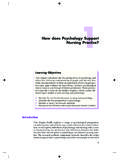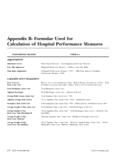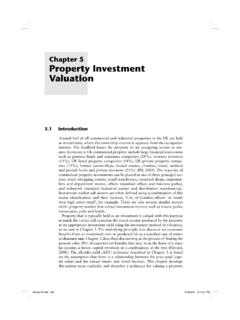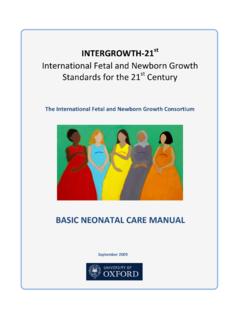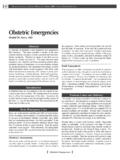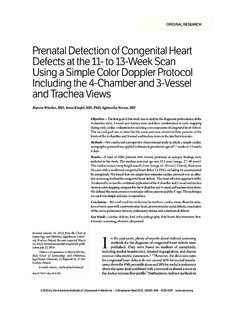Transcription of CHAPTER 1 Identifying fetal abnormalities - Wiley-Blackwell
1 BLUK112-RubinOctober 9, 200710:34 CHAPTER 1 Identifying fetalabnormalitiesLena M. MacaraKey points Days 18 55 postconception is the time of maximal teratogenicpotential when most organs are differentiating Teratogenic effects of medications may affect both organ structureand organ function Detailed ultrasound assessment of the fetus by trained personnelshould detect most major structural abnormalities , but minorabnormalities are often undetected Patients at risk of neural tube defects (NTDs) should have 5 mg offolic acid daily for a minimum of 6 wk prior to conceptionIntroductionIt is estimated that 2 3% of all pregnancies in the United King-dom are affected by congenital abnormality. Almost half of theseabnormalities remain of uncertain aetiology, a further 25% maybe linked to a variety of genetic problems and only 2% are likelyto be associated with environmental factors that include this is a very small proportion of all birth defects, it is a crit-ical group, since the avoidance of some medications will preventthese abnormalities from occurring.
2 For parents and physicians, itis therefore one of the few areas in which the outcome of preg-nancy can be in Pregnancy,4th edition. Edited by Peter Rubin and Margaret Ramsay,c 2008 Blackwell Publishing, ISBN: 9, 200710:342 CHAPTER 1 Both the number and spectrum of medicinal products avail-able, over the counter and on a prescribed basis, has expandedenormously in the last decade. At any given time, over 80% ofwomen in childbearing years are using some type of medicationand around 50% of pregnant women are prescribed a medicationother than a vitamin or supplement during pregnancy [1,2].This CHAPTER aims to guide clinicians on normal pregnancy de-velopment, the options currently available to assess fetal devel-opment in utero and the spectrum of abnormalities linked withdrug use during pregnancy, which may be detected prior to deliv-ery.
3 The following chapters will provide guidance on prescribingin pregnancy, highlighting those drugs that should be avoided inpregnancy and offering direction on those medications with leastrisk to the pregnancy while ensuring that the underlying medicalissues are dealt and fetal developmentIt is clear from practice that not all drugs affect a pregnancy inan identical manner or to equal degrees of severity. This is dueto the rapid but staggered sequence of events that occur as twocells quickly multiply to form the embryo and fetus we the order and timing of this process may help us tounderstand which organ systems are likely to be affected at eachstage of pregnancy and anticipate the possible long-term effectswhich may development can be divided into three main stages: thepre-differentiation or pre-embryonic phase; from conception un-til 17 days postconception, just after the first missed period; theembryonic stage from 3 to 8 weeks postconception and the fetalphase from week 8 until the pre-differentiation stage, the cells of the conceptusdivide rapidly and remain totipotential.
4 Any insult to the preg-nancy during this phase seems to have an all or nothing most of the cells are affected, the pregnancy is spontaneouslymiscarried but when only some cells are affected, the remainingtotipotent cells appear to replace the damaged cells without anyapparent long-term deleterious effect. Most women will not yethave missed their first period and therefore may not realise thatthey are the embryonic period, these cells differentiate and formdefinitive organ systems (Figure ). Since the cells have nowBLUK112-RubinOctober 9, 200710:34 Identifying fetal abnormalities3 Period of dividingzygote, implantationand bilaminar embryo1 2 34 56789163238 Embryonic discMorulaAmnionEmbryonic discNot susceptible toteratogenesisDeath of embryo andspontaneous abortion commonBlastocystNeural tube defects (NTDs)Main Embryonic Period (wk) fetal Period (wk)TA, ASD and VSDA melia/meromeliaUpper limbAmelia/meromeliaLower limbCleft lipUpper lipLow-set malformed ears and deafnessMicrophthalmia, cataracts, glaucomaEnamel hypoplasia and stainingCleft palateMasculinisation of female genitaliaExternal genitaliaPalateCommon site(s)
5 Of actionof teratogensLess sensitive periodHighly sensitive periodMajor congenital anomaliesFunctional defects and minor anomaliesTeethEyesEarsHeartMental retardationCNSTA, Truncus arteriosus; ASD, Atrial septal defect;VSD, Ventricular septal defectFigure timing of fetal development. Critical time periods for development of organ from Figure from Moore et al: The Developing Human: Clinically Oriented Embryology, 6/Ec 1998 with permissionfrom ElsevierBLUK112-RubinOctober 9, 200710:344 CHAPTER 1differentiated, if they are extensively damaged, permanent effectsare likely to occur in the end organ. Although the embryonic pe-riod is short, each end organ has a window of maximal suscepti-bility when the teratogenic insults are likely to be most severe.
6 Insome circumstances, the effects may be dosage fetal period is primarily a time of growth and maturation,and most drugs are therefore unlikely to cause significant struc-tural defects. However, organs such as the cerebral cortex, the gas-trointestinal tract and the renal glomeruli continue to differentiateand develop throughout pregnancy and into the neonatal organs therefore remain vulnerable to growth or functionaldamage by medicinal products during the later stages of are often more subtle changes and frequently will only be-come evident as the neonate grows and develops. The teratogeniceffect of a drug administered during pregnancy may therefore beeasily the nature and degree of teratogenic effects on a preg-nancy is largely determined by the stage of development at whichexposure occurs, the gestational age of the pregnancy at presenta-tion must first be determined.
7 Thereafter, careful documentationof the nature, dosage and duration of the products used should berecorded for future gestational age in pregnancyThe pregnancy hormone human chorionic gonadotrophin can bedetected in urine around the time of the first missed period, andin serum even earlier. Transvaginal ultrasound (TV) can now visu-alise a pregnancy 2 3 weeks following conception, though viabilityof the pregnancy can only be determined once a fetal heartbeat isseen 3 4 weeks postconception by TV scan or 4 weeks postcon-ception with an abdominal ultrasound scan. Thereafter, standardmeasurements of the total fetal length, fetal femur length and fe-tal skull diameter may be obtained to calculate the gestational ageof the fetus.
8 Pregnancy is divided into three trimesters: the firsttrimester from the time of the last menstrual period, week 0 untilweek 12, the second trimester from week 12 until week 24 andthe third trimester from week 24 until fetal anatomyWith good quality ultrasound machinery, basic fetal anatomy, con-firming integrity of the skull bones, the abdominal wall, upperBLUK112-RubinOctober 9, 200710:34 Identifying fetal abnormalities5 NFigure normal nuchal lower limbs, and a fetal stomach, may now be identified bythe 12th week of gestation. Many units also assess the depth ofnuchal fluid present at the fetal neck (Figure ). This, in com-bination with biochemical parameters, can quantify the risk ofchromosomal abnormality.
9 In addition, a large nuchal measure-ment (Figure ) is associated with increased risk of fetal cardiacabnormality, and detailed assessment of the heart at a later gesta-tion is advised. A more extensive examination of fetal anatomy inthe first trimester is performed in selected units. At 11 12 weeks,NFigure nuchal 9, 200710:346 CHAPTER 1a complete examination of the fetus can be achieved in only 50 60% of cases. With the addition of TV examination, and deferringthe examination until 12 14 completed weeks of pregnancy, 90%of pregnancies can be successfully examined [3,4]. While this op-tion offers early reassurance to parents, most departments do nothave the trained personnel, nor the resources to offer this level ofdetailed ultrasound examination in the first the majority of patients, fetal anatomy is still evaluated be-tween 18 and 20 weeks of gestation the routine anomaly scan.
10 Though this is recommended for all pregnancies, at the time ofwriting, routine anomaly scans are still not available within somemajor health board areas in Scotland and England unless specificindications such as medication in pregnancy are groups have evaluated second trimester ultrasound ex-amination and confirmed that 70 90% of significant abnormal-ities should be detected [5,6]. There are several reasons for thisvariation. The list of structures that are deemed essential to ex-amine in each pregnancy is at the discretion of individual units,and many departments do not examine the fetal heart, face orlimbs in detail. Therefore an examination may be complete as perdepartment protocol but may not evaluate the very organ mostlikely to be affected by specific drugs.




